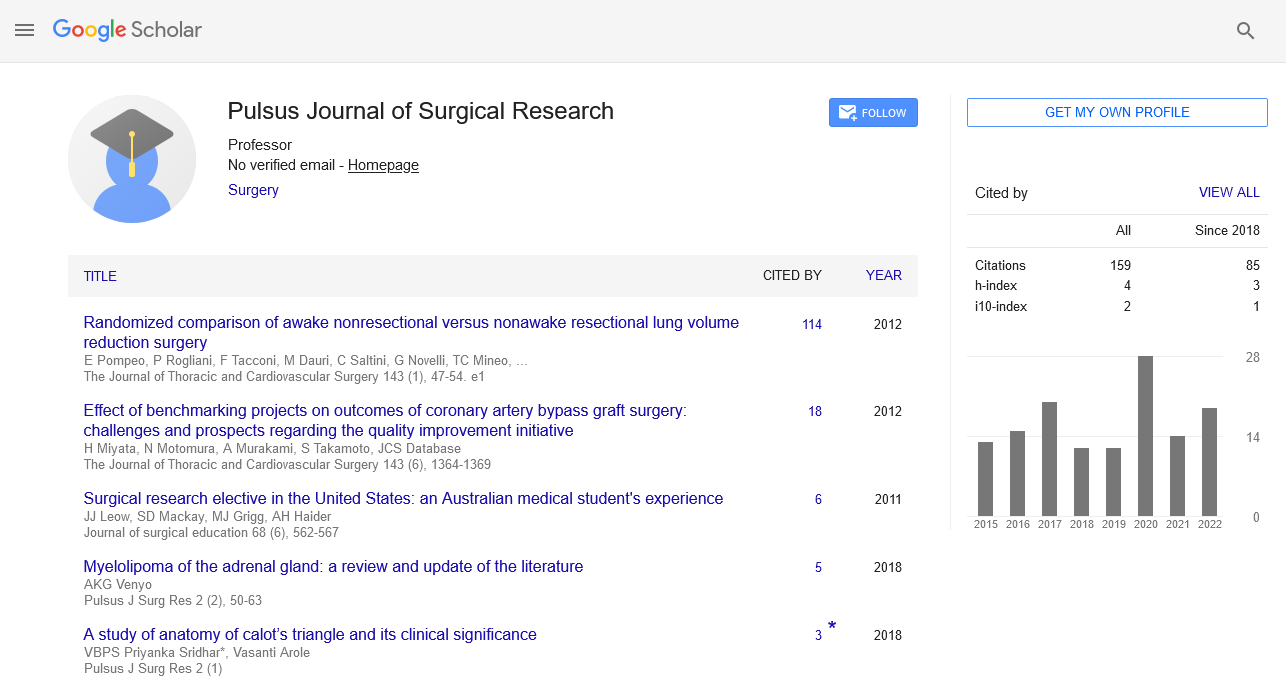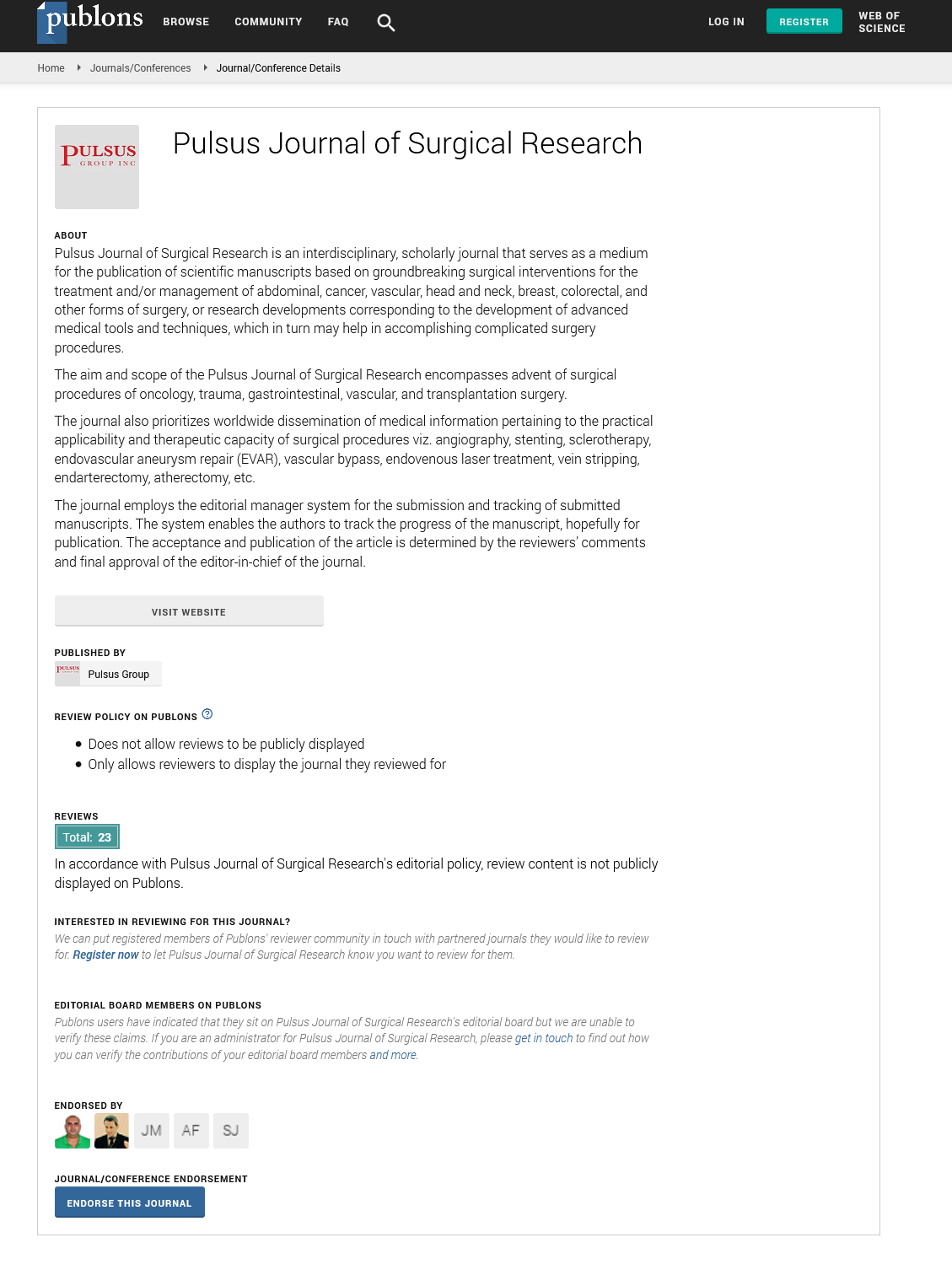Surgical catastrophe brought on by a hernia mesh infection and a poor course of care
Received: 03-Aug-2022, Manuscript No. pulpjsr- 22-5746; Editor assigned: 06-Aug-2022, Pre QC No. pulpjsr- 22-5746 (PQ); Accepted Date: Aug 26, 2022; Reviewed: 18-Aug-2022 QC No. pulpjsr- 22-5746 (Q); Revised: 24-Aug-2022, Manuscript No. pulpjsr- 22-5746 (R); Published: 30-Aug-2022
Citation: Divya S . Surgical catastrophe brought on by a hernia mesh infection and a poor course of care.J surg Res. 2022; 6(4):52-54.
This open-access article is distributed under the terms of the Creative Commons Attribution Non-Commercial License (CC BY-NC) (http://creativecommons.org/licenses/by-nc/4.0/), which permits reuse, distribution and reproduction of the article, provided that the original work is properly cited and the reuse is restricted to noncommercial purposes. For commercial reuse, contact reprints@pulsus.com
Abstract
A patient is shown who has a recurring, enormous ventral hernia and a mesh infection. The hernia mesh infection took five surgeries, several months to treat, and additional months to handle issues brought on by mesh removal. Surgical procedures under general anesthesia, as well as radiologic, microbiological, and laboratory tests, were completed during the most recent hospitalization. A total of seven antibiotics were recommended for days. If a surgeon is working in an area of surgery that is not routinely done, it can be difficult to keep up with the most recent
evidence-based techniques. Both tactical and surgical technique errors are significant contributors. A surgical strategy that fluctuates between precision and error can trigger a series of problems and surgical blunders that ultimately lead to life-threatening complications. The challenges associated with hernia mesh infection and illustrates the effects of a poor surgical approach on the healing process.
Key Words
Surgical care; Growth survival; Ventral hernia; Mesh infection
Introduction
Surgical pathology therapy options carry a larger probability of failure than they did a century ago. A variety of surgical techniques and equipment are now available for abdominal hernia repair as a result of quick technological advancement, making clinical judgment more difficult in some circumstances. An infection of the hernia mesh is a "surgical disaster" that has a terrible impact on everyone involved. A significant illustration of the tragedy brought on by a poor surgical plan is the case study being discussed right now. Based on SCARE criteria, this work has been reported. Marine bivalves are simultaneously influenced by a wide range of environmental conditions. Temperature and salinity are the two most significant abiotic master variables that influence the growth and survival of marine bivalves. In this regard, research has been done on the combined effects of temperature and salinity in a number of marine pearl oysters. For instance, juveniles' growth is slowed down when temperature-salinity circumstances are suboptimal because their clearance rate sharply decreased. The black-lip pearl oyster (Pinctada margaritifera) has been shown to have the best reproduction when temperature and salinity are present. Larval growth and survival also rise with temperature and salinity and reach their maximum levels at these conditions. In certain other marine species, including fish, the combined effects of temperature and salinity have also been documented. The capacity to identify the presence of interactions between relevant factors is one of the major advantages of multifactor studies over studies that simply look at the influence of a single factor. The impact of one component will be altered by another if there is an interaction, whether it be positive or negative. As a result, the unifactor studies' reports of the ideal culture conditions are no longer valid. One of the most important and technically challenging stages of pearl oyster Pinctada fucata larval culture is larval cultivation. Greater larval growth and survival are crucial safeguards for the pearling industry's sustained expansion. Hatchery-reared larvae are particularly sensitive to changes in the surrounding environment because they are still ontogenetically in the planktonic stage. As a result, environmental parameters are crucial to the success of larviculture, calling for accurate assessment of larval growth and survival as well as environmental condition optimization. Fortunately, experimentation and contemporary hatchery culture techniques give the larval cultivation greater opportunities to prosper in these areas. The objective of the current study was to identify the optimal temperature-salinity settings for pearl oyster larval culture by examining changes in the growth and survival of larvae under simultaneous adjustments in temperature and salinity. These have not yet been reported, as far as we know. By looking into how temperature and salinity interact to affect larval growth and survival, this study will fill in a knowledge vacuum. It would be beneficial to develop methods for more effective large-scale larviculture of the pearl oyster species by determining the ideal culture conditions for larvae, which is a crucial step in enhancing hatchery production. The Housing Pearl Oyster Culture Farm provided the bloodstock for the spawning pearl oysters used in this study. Bloodstock with welldeveloped gonads was stimulated by exposure to shade after the biofoulings were removed. They were then transferred into an aerated fiberglass tank with filtered seawater at temperature and salinity for additional stimulation by flowing water, allowing them to spawn and fertilize naturally. The validity of the models developed in this study should be assessed because one of its main goals was to develop models of larval growth and survival. The models' great adequacy was demonstrated by the lack-of-fit test, which showed that they had exceptional predictive capacity based on those coefficients of determination and a very good match to experimental data. Additionally, mistakes' normalcy and homoscedasticity need to be examined. Simply looking at the graphs revealed that experimental points were evenly spaced out along a straight line, indicating the error of normalcy. It is without a doubt of considerable realistic significance to realize a precise evaluation of the growth and survival of hatchery-reared larvae, necessitating the establishment of credible models. In this work, temperature and salinity-related models of larval growth and survival in pearl oysters were developed. Variability in larval growth and survival could be described by the models. These results showed that the models were highly accurate at predicting larval growth and survival. This is the first time that these models have been developed in larvae. The objective of accurately tracking larval growth and survival utilizing two crucial environmental parameters was accomplished. Reliable simulations of significant environmental elements. The effect of salinity on the development rate and abyssal fiber secretion of spat and adults of Pinctada margaritifera is not well understood. In order to determine the salt tolerance of spat as well as the effects of various salinity gradients on the development rate and abyssal fiber secretion of spat under laboratory settings, the current studies were created. Both judgments regarding the farm grow out of spat and hatchery management of spat stock may benefit from this. The study also concentrated on the potential for removing settling tanks by salinity modification to simplify the transfer of spat to grow-out farms. Spat that have been physically removed from hatchery tanks experience increased stress in their new environment, which increases mortality. Due to a nonhealing wound, the patient was readmitted to the prior surgical facility two weeks after being discharged. The defect's diameter and height were confirmed by a CT scan as an early hernia recurrence.
Upon investigation, serous discharge and a fibrin film around the mesh were discovered. This was thought to be a typical aseptic inflammatory reaction to the mesh. Eight months after the first release, the patient was readmitted to the hospital of the article's author with complaints of purulent discharge from the surgical site and skin opening.
Both an infection of the hernia mesh and a sizable, recurring, irreducible ventral hernia were confirmed. Because the infection persisted, two attempts to partially remove the mesh were unsuccessful. After the third effort, the mesh had been completely removed. The patient was sent home with a secondary healing wound and instructions to come back after the granulation phase had been reached for skin grafting. Six weeks later, the patient returned and complained of a fresh, purulent skin opening about six inches away from the freshly granulated area. Due to the considerable danger of injuring the visceral organs in a dense tissue conglomerate, the sinus tract open revision was abandoned and mesh finding was unsuccessful. The second postoperative day saw the evisceration of a tiny intestinal loop, which was managed conservatively. On discharge, it was advised to continuously create sinus tracts. The application of any surgical attempts to close the defect was discontinued. Five months after a hermetic fixation of the stoma bag was performed, the patient was released from the hospital after the defect spontaneously healed. To summarize, it took months and five procedures to treat the hernia mesh infection, and months were needed to handle the complications associated with mesh removal. Throughout the hospitalization, the patient was there for several months. Surgical procedures under general anesthesia and radiologic, microbiological, and laboratory tests were carried out throughout that hospitalization. A total of seven antibiotics were recommended for days. Many incorrect activities were discovered after the fact. Last but not least, since sigmostoma was obtained in place of the mesh infection and the enormous hernia was not corrected, the patient did not clearly benefit from the procedure. The scope of surgical procedures has been expanded across all surgical specialties because of technological advancements. In the days before the development of hernia implants, a surgeon would not attempt to treat a massive ventral hernia with domain loss. But as this case report demonstrates, the implant by itself is insufficient for a satisfactory outcome. Additionally, a negative occurrence could be brought on by any medical gadget. Due to the fact that these incidents are vastly underreported, it is impossible to determine their true frequency, particularly those caused by improper device uses. To get rid of the infection, the mesh that has been affected for a while needs to be entirely removed. But the difficulties in diagnosing the infection's severity, particularly after implantation when surgery givesae false impression that the entire mesh has been removed, is a problem. Mesh fragmentation makes any subsequent attempt more challenging. Particularly difficult to deal with are little contaminated mesh bits. Another issue is from the visceral organs' near proximity to the infected implant, which increases the possibility of harming them during mesh removal. Since the sigmoid fistula in the case at hand first manifested on the tenth postoperative day, the true origin of it cannot be determined. Fistula formation is influenced by infection, stress to the colon wall during mesh separation, and colon ocalization outside of the abdominal cavity in an open wound. A surgical challenge for a surgeon and severe discomfort for the patient with a negative impact on life quality is an enter atmospheric fistula in an open wound. The case patient experienced a life-threatening complication as a result of a questionable attempt to quickly address that problem. When the operation for flap wound closure failed, the patient actually faced a death threat. As a result, the wound's local condition was restored to its original location, delaying recovery for several months. Despite the severe faecal pollution, the patient's wound cleaned itself and healed on its own without outside assistance. There have been case reports on flap perforation and burn caused by the diathermy device's transmitted heat. The traditional and Trans oral vestibular methods also carry the risk of hemorrhage, which is an additional consequence. The likelihood that hematomas will form during the A surgical strategy varying between error and accuracy can catalyze a chain reaction of complications and surgical errors, finally resulting in life-threatening complications. One person in our study required two outpatient department-based aspirations due to a postoperative seroma that had developed.






